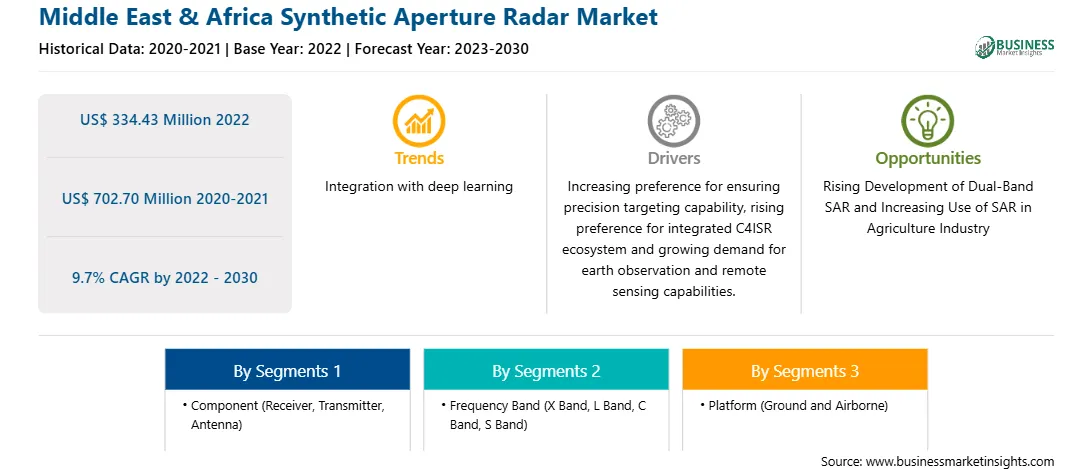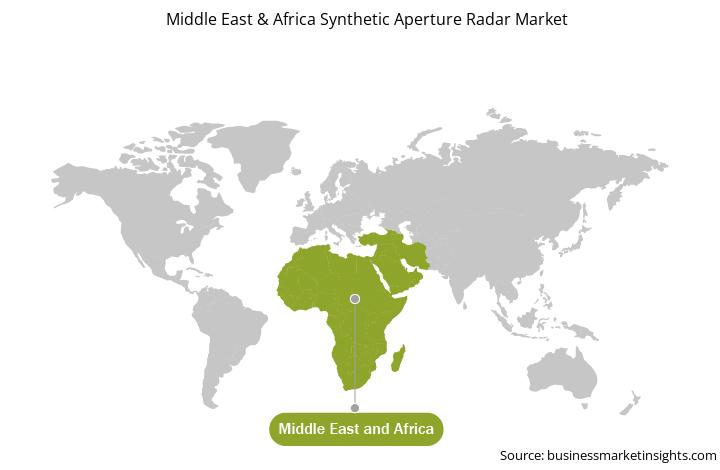Middle East & Africa Synthetic Aperture Radar Market
No. of Pages: 115 | Report Code: BMIRE00030598 | Category: Electronics and Semiconductor
No. of Pages: 115 | Report Code: BMIRE00030598 | Category: Electronics and Semiconductor
The Middle East & Africa synthetic aperture radar market was valued at US$ 334.43 million in 2022 and is expected to reach US$ 702.70 million by 2030; it is estimated to register a CAGR of 9.7% from 2022 to 2030. Integration with Deep Learning (DL) Bolsters Middle East & Africa Synthetic Aperture Radar Market
In recent years, deep learning, especially convolutional neural networks (CNNs), has revolutionized computer vision applications such as face recognition, driverless technology, and the Internet of Things (IoT). Deep learning techniques allow computational models to learn complex data representations, leading to significant improvements in performance across various applications. This advancement has also caught the attention of researchers in the field of remote sensing. Researchers have started exploring the potential of deep learning in remote sensing, realizing its value in enhancing remote sensing applications. Deep learning techniques have been successfully applied in various remote sensing applications, including target and oil spill detection, traffic surveillance, topographic mapping, AI-based synthetic aperture radar (SAR) imaging algorithm updates, coastline surveillance, and marine fisheries management.
The integration of deep learning algorithms with remote sensing technologies has yielded promising results. For instance, deep learning-based target detection algorithms have shown improved accuracy and efficiency in identifying specific objects or anomalies in remote sensing imagery. Similarly, deep learning techniques have been applied to SAR imaging algorithms, enabling better image reconstruction and analysis. The adoption of deep learning in remote sensing applications offers significant benefits for businesses operating in this domain. It allows for more accurate and efficient detection and monitoring of targets, such as oil spills or anomalies, enhancing environmental protection efforts. Deep learning-based traffic surveillance systems can improve transportation planning and management, leading to optimized logistics and reduced congestion. Moreover, the use of deep learning in topographic mapping and coastline surveillance can facilitate better land management decisions and coastal protection strategies.Middle East & Africa Synthetic Aperture Radar Market Overview
The Middle East & Africa synthetic aperture radar market is segmented into Saudi Arabia, South Africa, the UAE, and the Rest of Middle East & Africa. The region is focusing on developing space capabilities. The National Space Fund establishment by the UAE in 2022 is a significant development in the UAE's project to foster home-grown space talent, with the goal of building national capabilities and competencies, increasing economic contribution to diversifying the national economy, and consolidating the UAE's position in space. In 2022, the UAE Space Agency announced the National Space Fund worth US$ 817 million. In July 2022, the UAE announced its plans to develop a swarm of synthetic aperture radar (SAR) satellites under the Sirb project. The project will address the critical need for better environmental and land usage monitoring, data collection, and analysis to meet today's global challenges.
Several firms in the region are also partnering to deliver near real-time, high-definition images of on-the-ground conditions across the Middle East. For example, in November 2023, Bayanat AI and Al Yah Satellite Communications Company partnered to expand the earth observation (EO) space program from five to seven synthetic aperture radar (SAR) satellites. This partnership aims to deliver near real-time, high-definition images of on-the-ground conditions across the Middle East. Thus, such development in the region favors the growth of the synthetic aperture radar market.
Middle East & Africa Synthetic Aperture Radar Market Revenue and Forecast to 2030 (US$ Million)
Strategic insights for the Middle East & Africa Synthetic Aperture Radar provides data-driven analysis of the industry landscape, including current trends, key players, and regional nuances. These insights offer actionable recommendations, enabling readers to differentiate themselves from competitors by identifying untapped segments or developing unique value propositions. Leveraging data analytics, these insights help industry players anticipate the market shifts, whether investors, manufacturers, or other stakeholders. A future-oriented perspective is essential, helping stakeholders anticipate market shifts and position themselves for long-term success in this dynamic region. Ultimately, effective strategic insights empower readers to make informed decisions that drive profitability and achieve their business objectives within the market. The geographic scope of the Middle East & Africa Synthetic Aperture Radar refers to the specific areas in which a business operates and competes. Understanding local distinctions, such as diverse consumer preferences (e.g., demand for specific plug types or battery backup durations), varying economic conditions, and regulatory environments, is crucial for tailoring strategies to specific markets. Businesses can expand their reach by identifying underserved areas or adapting their offerings to meet local demands. A clear market focus allows for more effective resource allocation, targeted marketing campaigns, and better positioning against local competitors, ultimately driving growth in those targeted areas.Middle East & Africa Synthetic Aperture Radar Strategic Insights

Middle East & Africa Synthetic Aperture Radar Report Scope
Report Attribute
Details
Market size in 2022
US$ 334.43 Million
Market Size by 2030
US$ 702.70 Million
Global CAGR (2022 - 2030)
9.7%
Historical Data
2020-2021
Forecast period
2023-2030
Segments Covered
By Component
By Frequency Band
By Platform
By Mode
Regions and Countries Covered
Middle East and Africa
Market leaders and key company profiles
Middle East & Africa Synthetic Aperture Radar Regional Insights

Middle East & Africa Synthetic Aperture Radar Market Segmentation
The Middle East & Africa synthetic aperture radar market is categorized into component, frequency band, application, platform, mode, and country.
Based on component, the Middle East & Africa synthetic aperture radar market is categorized into receiver, transmitter, and antenna. The antenna segment held the largest market share in 2022.
In terms of frequency band, the Middle East & Africa synthetic aperture radar market is categorized into x band, l band, c band, s band, and others. The x band segment held the largest market share in 2022.
By application, the Middle East & Africa synthetic aperture radar market is segmented into commercial and defense. The defense segment held a larger market share in 2022.
Based on platform, the Middle East & Africa synthetic aperture radar market is bifurcated into ground and airborne. The airborne segment held a larger market share in 2022.
In terms of mode, the Middle East & Africa synthetic aperture radar market is bifurcated into single and multi. The multi segment held a larger market share in 2022.
By country, the Middle East & Africa synthetic aperture radar market is segmented into South Africa, Saudi Arabia, the UAE, and the Rest of Middle East & Africa. The UAE dominated the Middle East & Africa synthetic aperture radar market share in 2022.
Northrop Grumman Corp, ASELSAN AS, BAE Systems Plc, Israel Aerospace Industries Ltd, Leonardo SpA, Lockheed Martin Corp, Raytheon Technologies Corp, Thales SA, and Saab AB are some of the leading companies operating in the Middle East & Africa synthetic aperture radar market.
1. Northrop Grumman Corp
2. ASELSAN AS
3. BAE Systems Plc
4. Israel Aerospace Industries Ltd
5. Leonardo SpA
6. Lockheed Martin Corp
7. Raytheon Technologies Corp
8. Thales SA
9. Saab AB
10. General Atomics Aeronautical Systems Inc
The Middle East & Africa Synthetic Aperture Radar Market is valued at US$ 334.43 Million in 2022, it is projected to reach US$ 702.70 Million by 2030.
As per our report Middle East & Africa Synthetic Aperture Radar Market, the market size is valued at US$ 334.43 Million in 2022, projecting it to reach US$ 702.70 Million by 2030. This translates to a CAGR of approximately 9.7% during the forecast period.
The Middle East & Africa Synthetic Aperture Radar Market report typically cover these key segments-
The historic period, base year, and forecast period can vary slightly depending on the specific market research report. However, for the Middle East & Africa Synthetic Aperture Radar Market report:
The Middle East & Africa Synthetic Aperture Radar Market is populated by several key players, each contributing to its growth and innovation. Some of the major players include:
The Middle East & Africa Synthetic Aperture Radar Market report is valuable for diverse stakeholders, including:
Essentially, anyone involved in or considering involvement in the Middle East & Africa Synthetic Aperture Radar Market value chain can benefit from the information contained in a comprehensive market report.